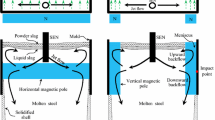Abstract
To improve the quality of horizontal continuous casting bronze thin slab, especially the end quality of the thin slab, three methods were proposed; (i) using silicon steel sheet at the ends of the traveling magnetic field (TMF), (ii) change in the length of TMF, and (iii) reduction in the ends current intensity of TMF. Then, the effect of these methods on the magnetic field, flow and solidification of thin slab was studied both numerically and experimentally. Results show that the use of silicon steel sheet is the best method to modify the magnetic field intensity distribution. Due to the electromagnetic field shielding effect of silicon steel sheet, when the silicon steel sheet with 150 mm length and 0.5 mm thickness was applied, the magnetic field intensity at the ends of TMF was reduced to about half of the original. However, the magnetic field intensity in the middle of TMF did not change, which assists the elimination of the strong flow of the melt at the ends of the mold and uniform the solidification shell of the melt. Then, the bronze thin slab can be successfully cast without any crack defects at the ends.








Similar content being viewed by others

References
M. Guo, R. Liu, and Z. Sun: Optimization of technological factors on QSn6.5-0.1 in horizontal continuous casting. Cast. Technol. 26, 591 (2005).
J.D. Hwang, B.J. Li, W.S. Hwang, and C.T. Hu: Comparison of phosphor bronze metal sheet produced by twin roll casting and horizontal continuous casting. J. Mater. Eng. Perform. 7, 495 (1998).
J.P. Lu, F.W. Dong, and S.L. Lei: Preliminary analysis of cause of cracks in QSn6.5-0.1 strip produced by horizontal continuous casting. Shanghai Nonferrous Met. 23, 62 (2002).
B. Bai: Application of electromagnetic stirring technology in continuous casting. Foreign Steel 11, 13 (1992).
T.J. Li and J.Z. Jin: Current status and future potential for electromagnetic processing of materials. Mater. Rev. 14, 12 (2000).
J.E. Spinelli, J.P. Tosetti, C.A. Santos, J.A. Spim, and A. Garcia: Microstrucutre and solidification thermal parameters in thin strip continuous casting of a stainless steel. J. Mater. Process. Technol. 150, 255 (2004).
M-G. Kim, S-Y. Sung, and Y-J. Kim: Microstructure, metal-mold reaction and fluidity of investment cast-TiAl alloys. Mater. Trans. 45, 536 (2004).
Z. Yu, W. Li, K. Deng, Z. Lei, and M. Ren: Flow and solidification of copper thin-slab in horizontal continuous casting with electromagnetic stirring. Spec. Cast. Nonferrous Alloys 28, 229 (2008).
W. Li, Z. Yu, and K. Deng: Flow and solidification characteristics of melt under electromagnetic stirring in horizontal continuous casting of copper thin-slab. Trans. Nonferrous Met. Soc. China 18, 1058 (2008).
C. Hui, T. Li, W. Jin, and J. Guo: Research on horizontal electromagnetic continuous casting of Sn–P bronze strip plate. Rare Met. Mater. Eng. 37, 721 (2008).
J. Li, K. Jin, X.G. Zhang, Q.Y. Ru, W.L. Zhou, and Y.M. Wang: Effect of electromagnetic field on quality of horizontal continuous casting QSn6.5-0.1 strip. Non-Met. Proc. 35, 15 (2006).
B.G. Thomas: Modeling of continuous casting defects related to mold fluid flow. Iron Steel Technol. 3, 2 (2006).
A.K. Dahle and D.H. StJohn: Rheological behaviour of the mushy zone and its effect on the formation of casting defects during solidification. Acta Mater. 47, 31 (1998).
J. Yamaguchi, T. Nakashima, and T. Sawai: Change and development of continuous casting technology. Nippon Steel Tech. Rep. 104, 13 (2013).
J. Zeng, W. Chen, Q. Wang, and G. Wang: Improving inner quality in continuous casting rectangular billets: Comparison between mechanical soft reduction and final electromagnetic stirring. Trans. Indian Inst. Met. 69, 1623 (2016).
H. Zhang, H. Nagaumi, and J. Cui: Coupled modeling of electromagnetic field, fluid flow, heat transfer and solidification during low frequency electromagnetic casting of 7XXX aluminum alloys. Part II: The effects of electromagnetic parameters on casting processes. Mater. Sci. Eng., A 448, 177 (2007).
C. Feng: Electromagnetic Field (People’s Education Press, Beijing, 1985); p. 493.
F. Wang: Computational Fluid Dynamics Analysis (Tsinghua University Education Press, Beijing, 2004); p. 272.
S. Ge, M. Isac, and R.I.L. Guthrie: The computational fluid dynamic (CFD) modeling of horizontal single belt casting (HSBC) processing of Al–Mg–Sc–Zr alloy strips. Mater. Sci. Eng., B 46, 2264 (2015).
Q. Zhang and C.L. Yi: Research of force and fluid during horizontal continuous casting of QSn6.5-0.1 strip by imposing double traveling electromagnetic field. Int. J. Adv. Comp. Technol. 4, 536 (2012).
ACKNOWLEDGMENTS
This research was supported by grants from the National Natural Science Foundation of China No. 51204101 and Application and the Basic Research of Qingdao No. 14-2-4-109-jch.
Author information
Authors and Affiliations
Corresponding author
Supplementary Material
Rights and permissions
About this article
Cite this article
Zhang, Q., Li, T. Optimization of traveling magnetic field for horizontal continuous casting of thin slab containing tin phosphor bronze. Journal of Materials Research 32, 3532–3539 (2017). https://doi.org/10.1557/jmr.2017.241
Received:
Accepted:
Published:
Issue Date:
DOI: https://doi.org/10.1557/jmr.2017.241




